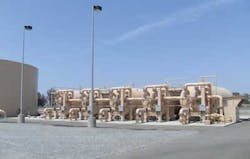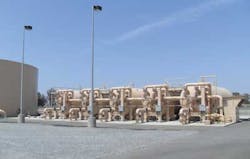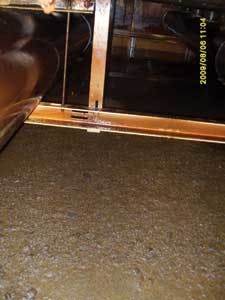By Cliff Lebowitz
Plant and operations management for an 18 mgd arsenic removal water treatment plant (WTP) in Corcoran, CA, have replaced filter media in their pressure filtration system to complete the process of eliminating a costly and troublesome polymer addition, while maintaining substantial cutback of ferric chloride (FeCl3). They also noted taking advantage of process expertise from the pressure filtration manufacturer to precipitate suspended FeCl3 in the backwash tanks without resorting to polymer re-introduction there.
The Corcoran facility started operation in June 2006 to remove arsenic from drinking water. Although the pressure filtration manufacturer did not recommend polymer usage for original plant startup, the city began adding polymer as a safety precaution to prevent breakthrough soon after the plant started operations. This led to a series of operational problems. The polymer addition was discontinued late in 2009. Filtration media was replaced late in 2010, and filtration capacity was increased a year later.
As a result of the media change in the arsenic removal system, arsenic concentrations dropped from the range of 6-8 ppb after polymer cessation, down to a range of non-detectable to 5 ppb. The USEPA Arsenic Rule, in effect as of January 2006, requires all potable water systems to provide water with an arsenic concentration of 0.010 mg/L (10 ppb) or less.
Also as a result of the media replacement, management reports filter run times have increased from 8 hours to 48 hours. The original elimination of polymer had increased filter runs from 4 hours to 8 hours. FeCl3 dosing has remained at about 4.0 mg/L, down from 12.0 mg/L before elimination of the polymer.
"We had maintained arsenic removal at the levels we needed when we eliminated the polymer, as the filtration manufacturer said we would, and we saw some gains in filter run time, but we still had a mess in the filters," said Steve Kroeker, public works director and chief water plant operator for the City of Corcoran. "Now they've changed out all the media, and we made some changes in our procedures. They did their job and we did ours, and now everything is working fine."
Average flow at the facility is 5000 gpm, or 7 mgd. Seasonal variation has been from 3 mgd to about 12 mgd, with the gross treatment capacity at 18 mgd. The groundwater source is comprised of nine deep wells, ranging from 300 ft. to 1000 ft.
Nine deep wells all yield water with arsenic levels greater than 10 ppb. When yields from each are combined at the blend tank for hypo treatment, arsenic levels range from 20-30 ppb. Groundwater is pumped to a 500,000 gallon raw water blend tank. As raw water enters the tank, sodium hypochlorite is applied at 3.85 mg/L, both for disinfection and to oxidize arsenite (As3 ) to arsenate (As5 ), making it readily precipitable.
Six filter feed pumps draw from the raw water tank to a common manifold containing a static mixer. There, 39% ferric chloride (FeCl3) is added at 3.8 mg/L, as a bonding agent for the arsenic, and thereby creating larger particles for filtration. Each of six pressure filters operates at 2500 gpm, with discharge to a 2 million gallon finished water tank.
The manufacturer of the arsenic removal system and related equipment is Tonka Equipment Co. of Plymouth, MN. Before the polymer was discontinued, Tonka had conducted a 40-day pilot test of the arsenic water treatment, at no cost to the city, using reduced FeCl3 and no polymer addition. They then conducted a 30-day pilot test before installation of the new media, and also helped management find a solution to persistent FeCl3 suspension in the backwash tanks without resorting to re-introduction of polymer there - again at no cost to the city.
"When we started off in 2006, the engineers were shooting for arsenic below 3 ppb, so we had FeCl3 at 12.0 mg/L, and polymer at 1.2 mg/L," said Joe Faulkner, lead shift operator. "But we were getting breakthrough at the end of the filter runs, and the polymer was gumming up the filters. A filter run was supposed to be 8 hours, but it was cut to 4 hours with a head loss of 8 to 12 psi before backwashing."
The use of the polymer apparently was creating an iron/polymer sludge on top of the media, which the water could not penetrate. With much of the water following the path of least resistance, it would channel along the sides of the filter, rather than through the media as it should.
The plant used the polymer for about three years, at the rate of six to seven 250-gallon totes per year. Based on Tonka's piloting results, FeCl3 feeds were reduced and polymer addition was eliminated, thereby achieving significantly reduced costs, while still keeping the arsenic levels below the MCL of 10 ppb.
Not only was there no longer a need to purchase the polymer, but the need for the maintenance of the polymer injection equipment was eliminated, and a reduction of man-hours needed to operate that portion of the plant treatment processes was realized.
In addition, plant management noted additional costs associated with the problems potentially linked to the use of the polymers, such as short filter runs, the time to determine what the problems had been, and the eventual cost of replacing the media.
According to the operators, during the backwash cycles, when the water would channel, it would lift the media higher than it was designed for, causing a substantial loss of media. Approximately eight inches of media was lost from each filter per year.
"The polymer remaining in the filters turned into balls, like pieces of gum," Faulkner said. "We were still losing anthracite because of those mud balls. So we tried going down 4 or 5 in. into the anthracite to remove the mud balls, but we could not remove all of that residual polymer material."
"When the mud balls went through the air wash, they dropped to the gravel, and created a barrier where the water couldn't flow up. We were still doing all right with the compromised media, but were looking forward to replacing it, which we believed was the only way to completely solve the problem."
Media replacement was accomplished in two weeks, without any problems. Airwashes were replaced at the same time.
"It's pretty amazing what new media can do," said Faulkner. "Running the plant at 6 mgd now, we're getting 48 hour filter runs. We're only backwashing even at that rate just to be safe, to help prevent compacting of the top layer of media. Similarly, when flow goes up to 10 mgd, we'll go to backwashing once a day."
Faulkner also noted special assistance from Tonka in solving persistent suspension of FeCl3 in the backwash tanks.
"The polymer used to help settle that out, but with the polymer gone, now it was staying suspended in the water," he said. "That equipment didn't have anything to do with Tonka's product, but they helped us anyway, and they did it gratis. Nothing we tried to solve the problem worked, and we were thinking of having to re-introduce the polymer there, but they came up with the idea of dosing the tanks with alum, and that has worked well."
The new filter media consists of 12 inches of gravel, 4 inches of torpedo sand, 18 inches of silica sand, and 12 inches of anthracite.
The operators use ongoing monitoring of iron and arsenic in the effluent to determine the effectiveness of the filtration process. Currently, the iron levels range from non-detectable (<0.01 ppm) to 0.12 mg/L, compared to a goal of no more than 0.3 mg/L of iron in the effluent stream, which is USEPA's secondary maximum contaminant level (SMCL).
Arsenic concentrations in the final finished water are still consistently below the Federal MCL of 10 ppb, ranging from non-detectable to 5 ppb.
About the Author: Cliff Lebowitz is an independent reporter and editor. His third-party case histories, sponsored by the primary vendor in the story, are based on interviews with end users and their engineering firms, and are approved by them for accuracy and completeness.






